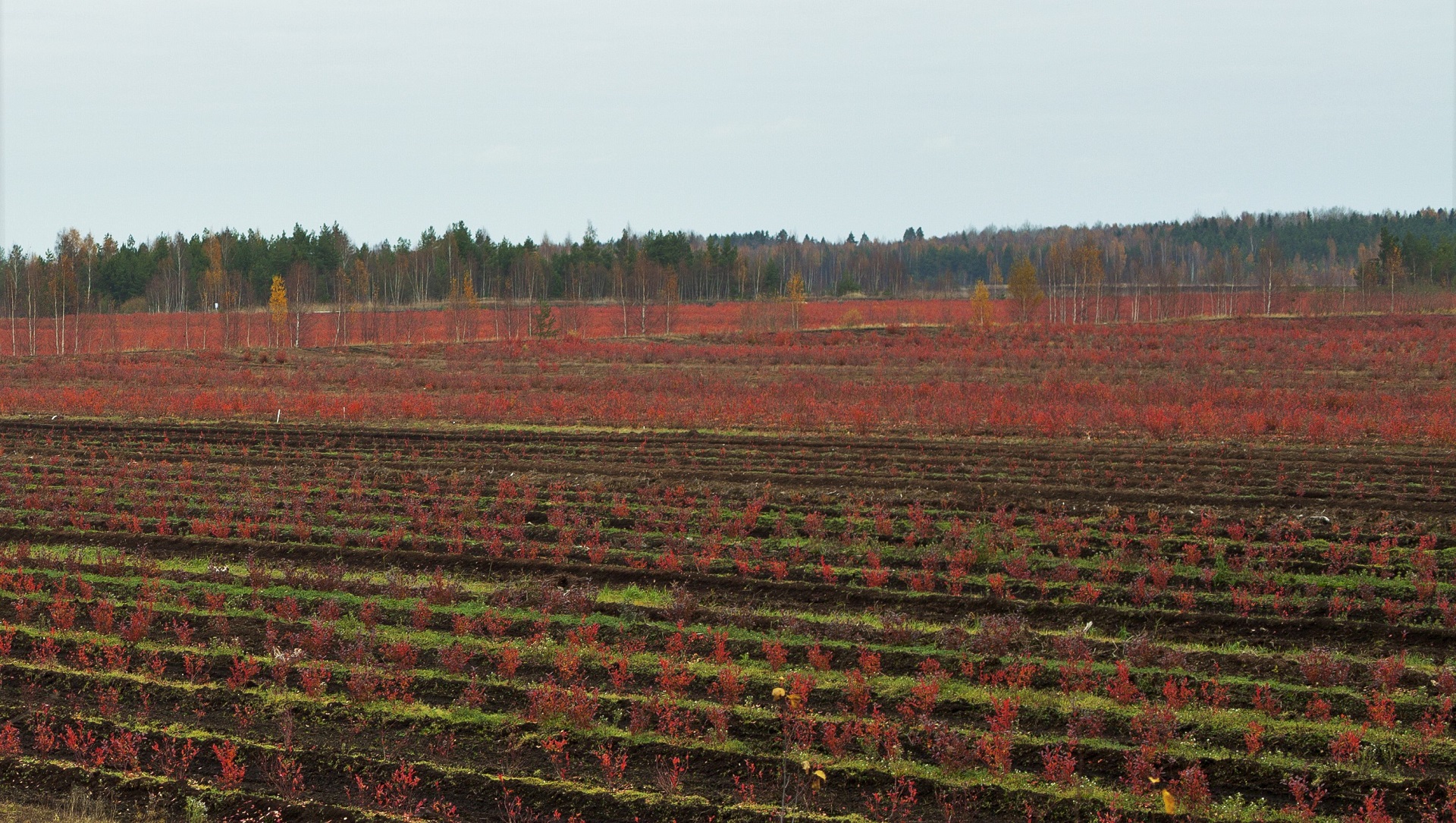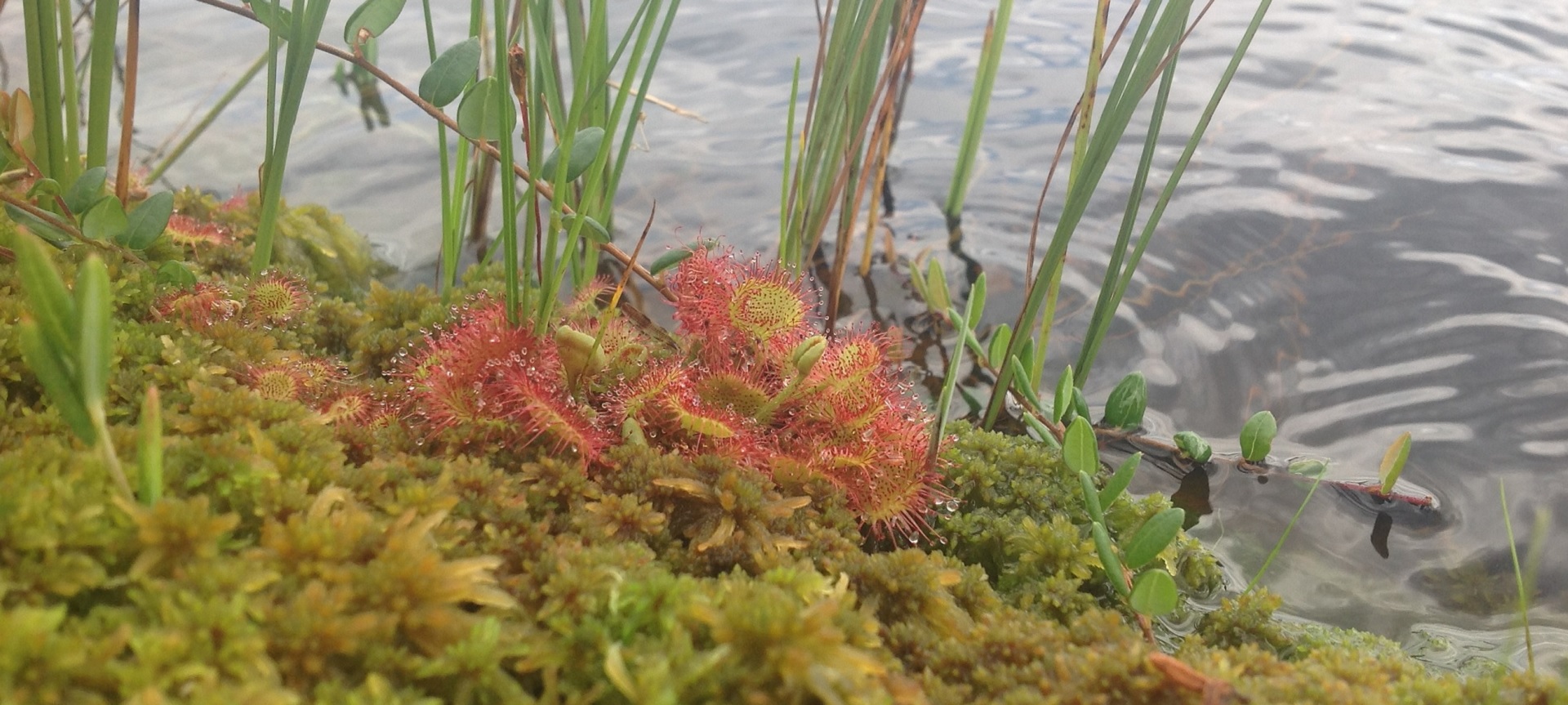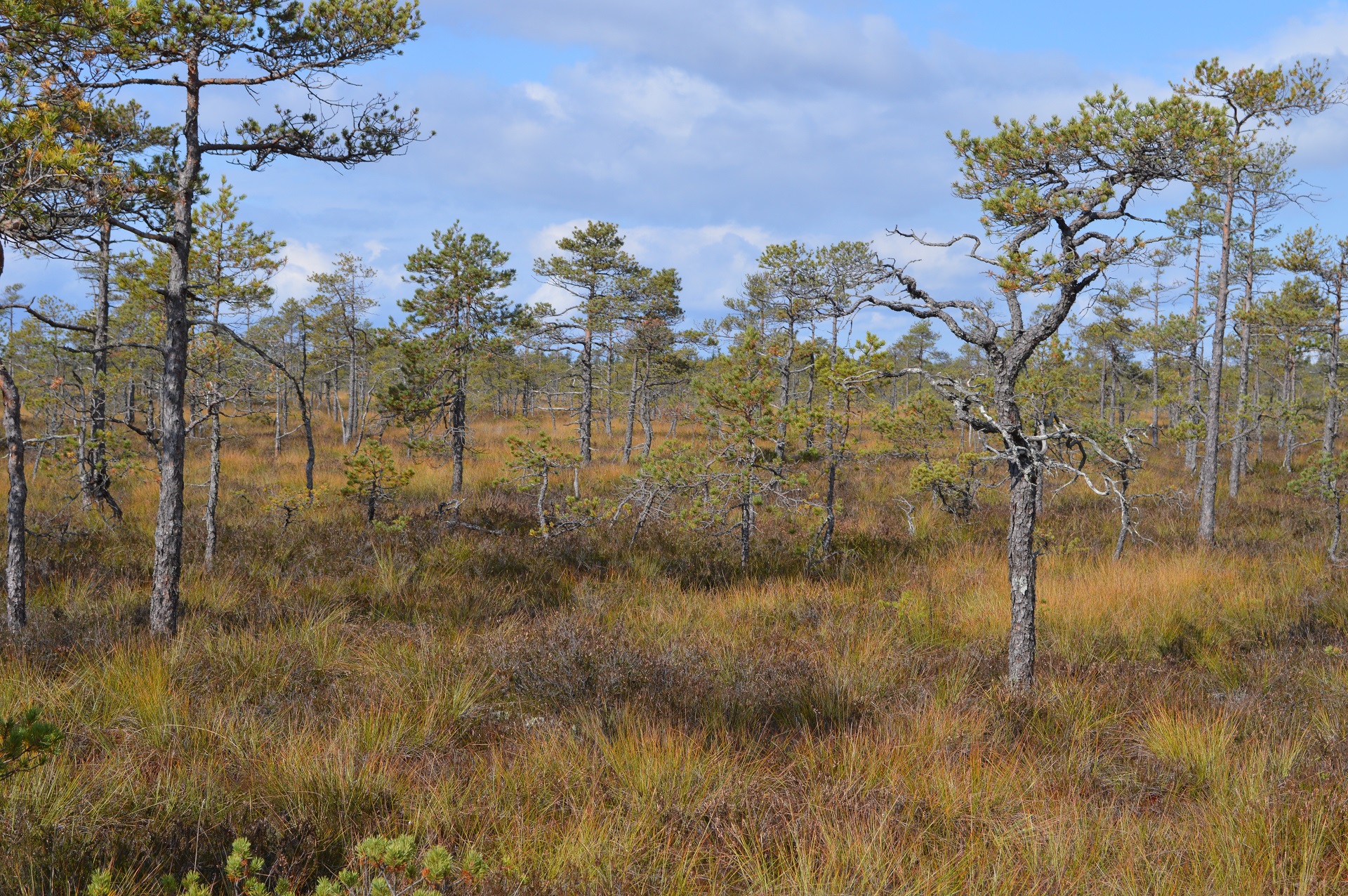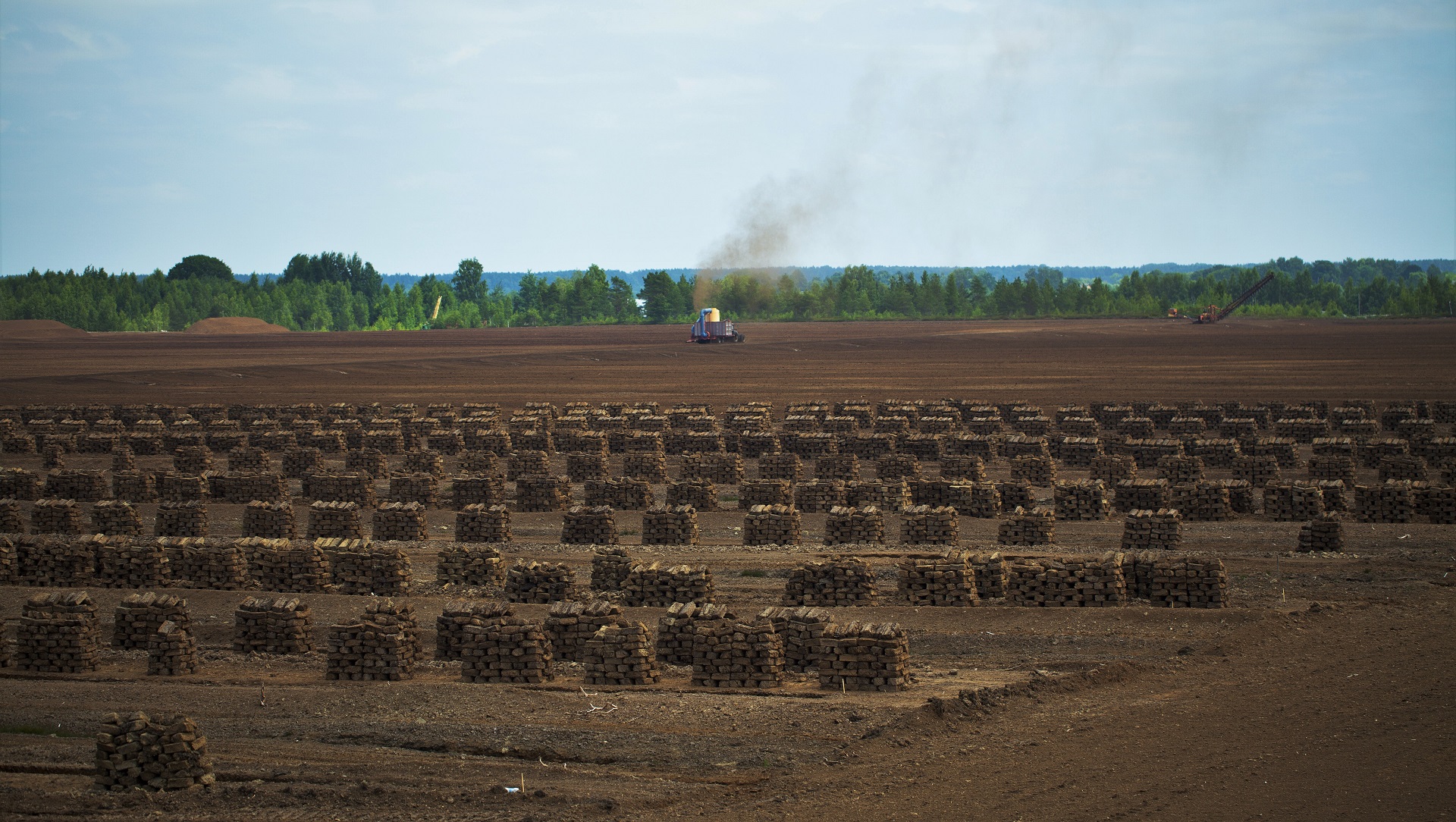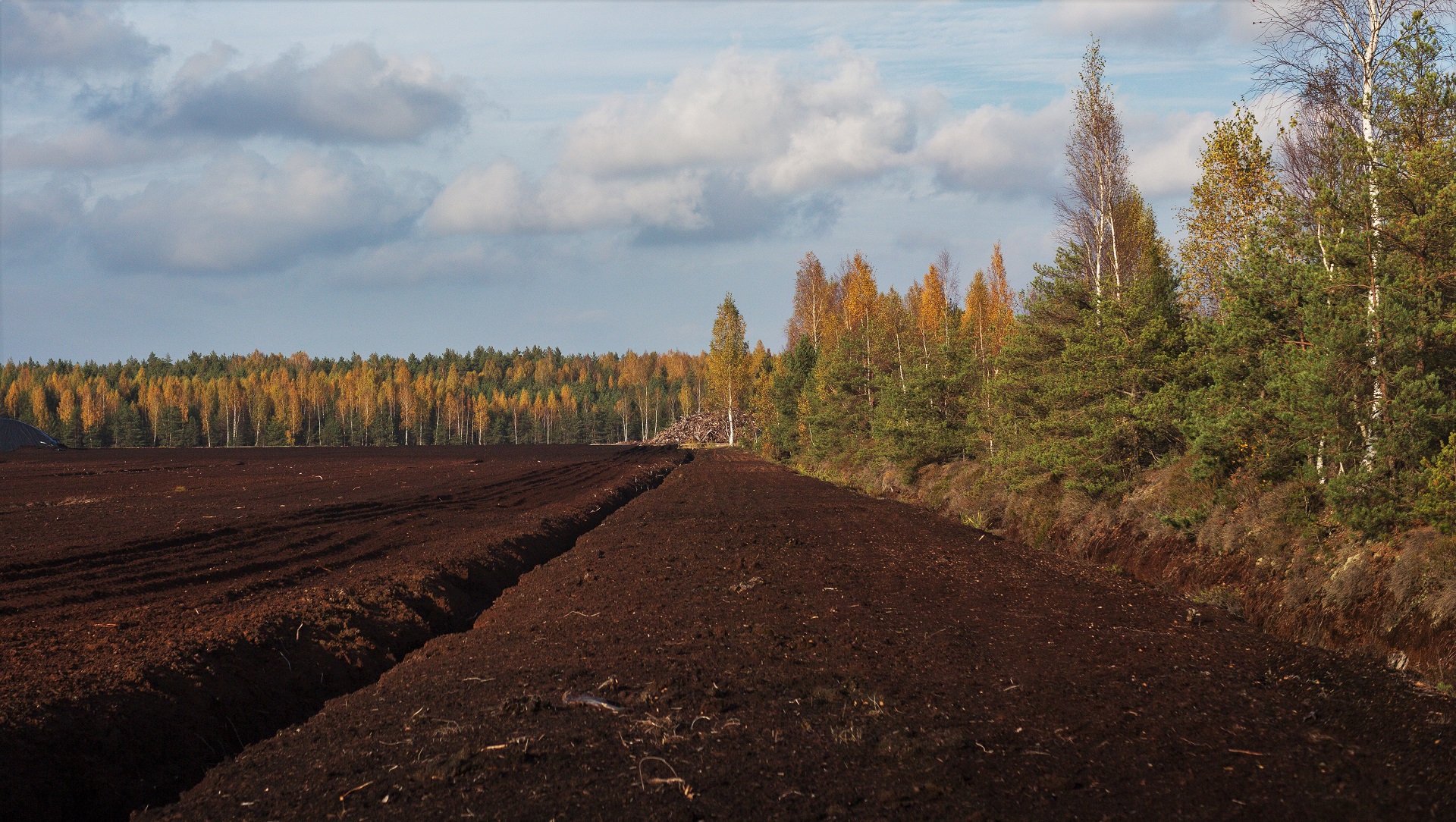Proposals of the Latvian peat sector concerning the Proposal for a Regulation of the European Parliament and of the Council establishing the Just Transition Fund
18 / 03 / 2020
Latvian peat industry wants to see the European Green Deal as an intention for the promotion of peat extraction for the horticulture and forestry use, for creating greater added value to peat products in Latvia, contributing to the national economy and population, as well as achieving climate neutrality through compensatory measures.
The European Green Deal should not be interpreted as an
intention to eliminate the peat extraction industry, but rather to
limit the use of peat fot energy production, which produces
industrial emissions.
CURRENT SITUATION
Of the peat extracted in Latvia, 95% is used for horticulture –
peat is used for growing food, ornamental plants, and tree
seedlings . Although peat extraction generates greenhouse gas (GHG)
emissions, carbon dioxide (CO2) is captured while peat is used for
the growing of the green plants.
The use of peat in Latvia differs significantly from other EU
countries (Ireland, Sweden, Finland and Estonia), as only 2% of the
extracted peat is used for energy purposes (burning for heating and
energy production, thus creating immediate GHG emissions).
In GHG inventory, emissions from peat are broken down as follows:
71% of the amount of peat extracted (accounting emissions): 1) in
the energy sector and 2) in the LULUCF sector. It should be
stressed that emission capture by plants grown in peat is not taken
into consideration. However, plants compensate the emissions
instead of producing immediate emissions which are calculated using
the "immediate oxidation" method defined in IPCC guidelines .
Emissions from degraded peatlands (historical, not after-used
peatlands) comprise 16%, 9% – from peatlands where currently peat
is being harvested; 5% - from after-used areas . In 2017, GHG
emissions from peatlands and areas related to peat extraction
accounted 14.5% of total GHG emissions, including the LULUCF
sector.
In the European Union, on average, GHG emissions have decreased by
23.5% since 1990, while in Latvia – by 56.9%. However, GDP has
increased by 58% on average in the EU and just by 16% in Latvia.
Therefore, maintaining the harvesting and processing of
horticultural peat as a successful and export-capable industry in
portfolio of extractive industries in Latvia is of national
importance.
Latvia's total GHG emissions in 2017 were only 0.26% of total EU
emissions.
Figure 1. Comparison between Latvia and the EU: reduction of GHG
emissions and GDP growth (1990-2017).
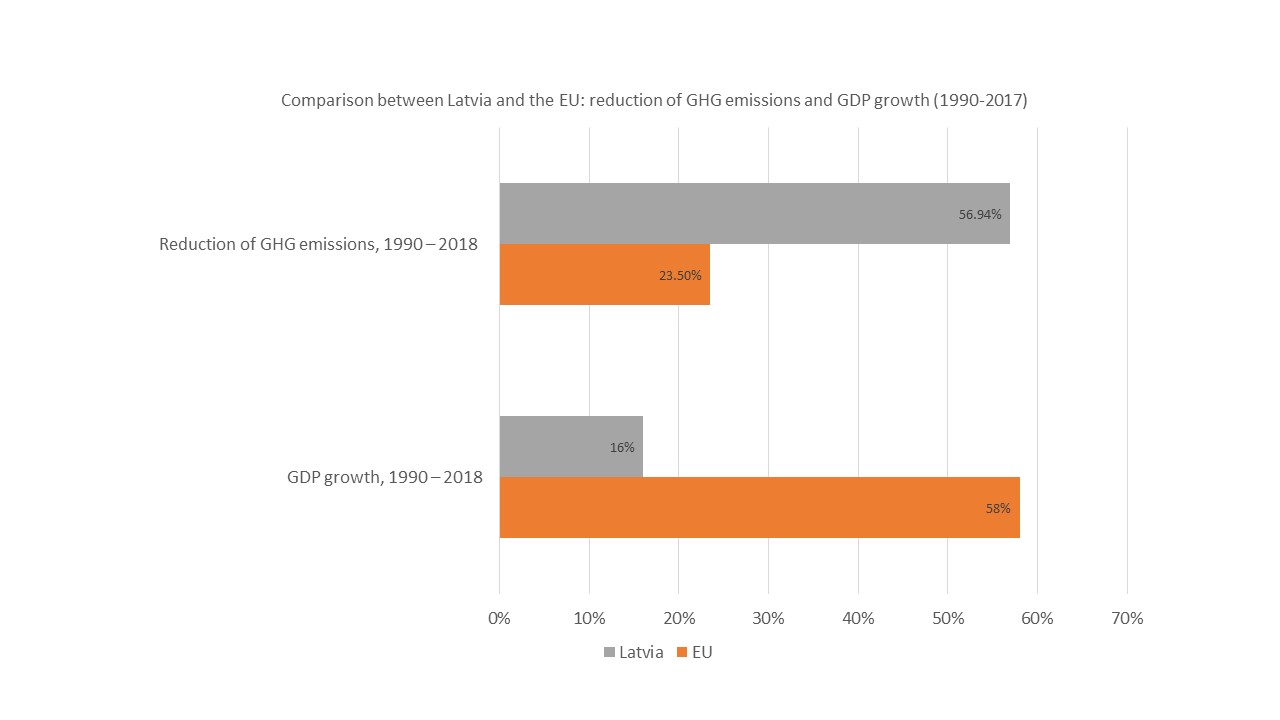 Figure 2. Reduction of GHG
emissions and GDP growth in Latvia (1990-2017)
Figure 2. Reduction of GHG
emissions and GDP growth in Latvia (1990-2017)
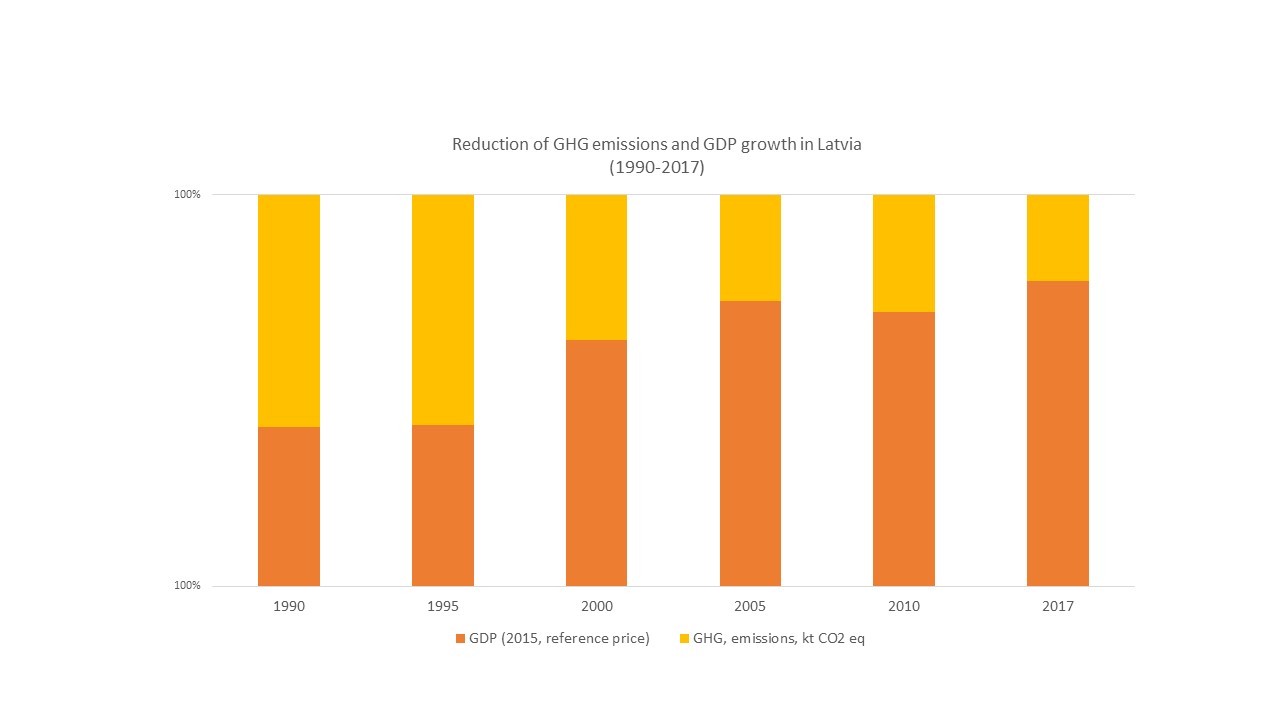
The dynamics of the proportion of peat used for energy production
and for horticulture in Latvia since 1990 shows that Latvia
has achieved the objectives of the EC Green Deal Initiative almost
20 years ago, in at least the peat extraction sector, and
the industry has already transformed to horticultural peat
extraction. The use of peat for energy production has decreased by
98.8% since 1990 and the share of peat in total energy consumption
in 2017 has reached only 0.01%.
Figure 3. Peat extraction in Latvia since 1990 – proportion of
energy peat and horticultural peat.
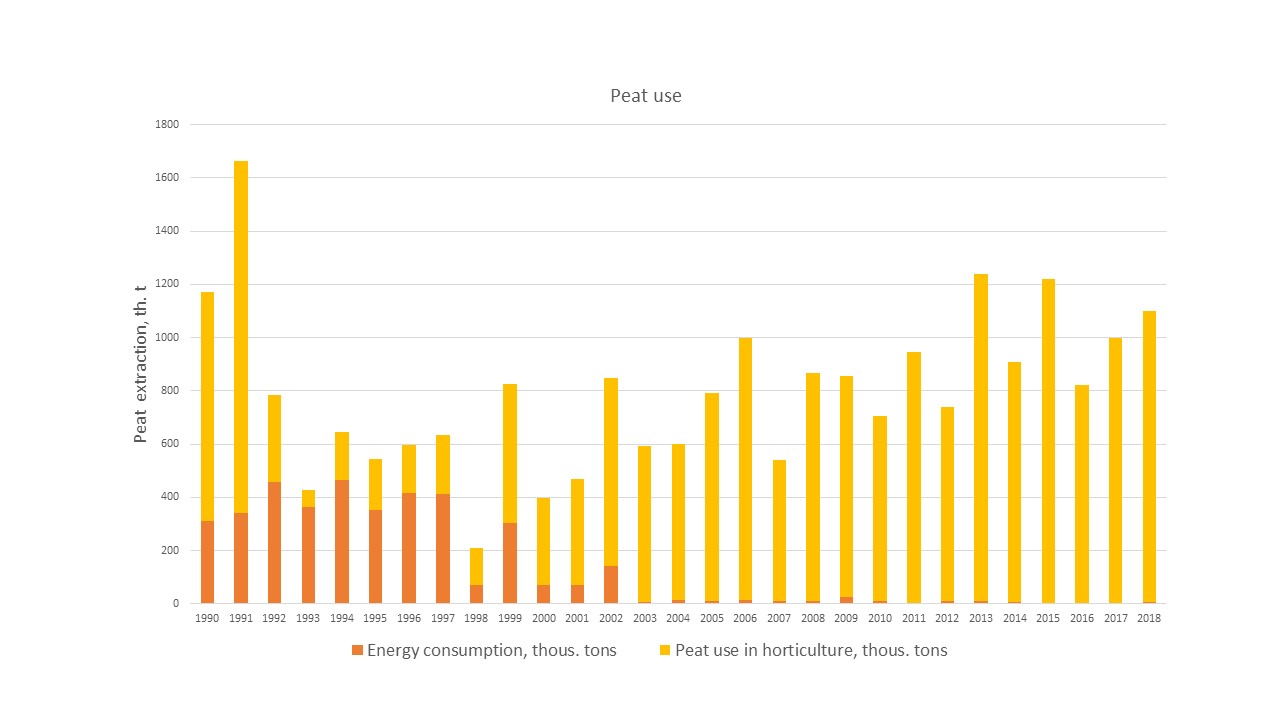
We would also like to emphasize that peat is an essential part of
the production of healthy food worldwide, it is the most
economically efficient substrate with the least 'ecological
footprint'.
VISION OF THE PEAT INDUSTRY
In 2050, peat extraction and processing are ongoing, and
the industry continues to work, providing jobs, primarily in the
regions, providing economic contribution, and sustainably using
natural resources for growth of Latvia.
The sector has been modernized, the types of peat use have
been improved, the created added value significantly increased, and
it contributes even more to the national economy and, as far as
possible, reduces GHG emissions.
GHG emissions, which are inevitable to a certain extent in
the industry, are compensated by after-use measures of
post-harvested peatlands – for example, through afforestation,
creation of plantations of blueberries or cranberries, or by other
compensatory measures, such as wind parks in post-harvested
peatlands, etc.
Figure 4. Predicted turnover in peat industry
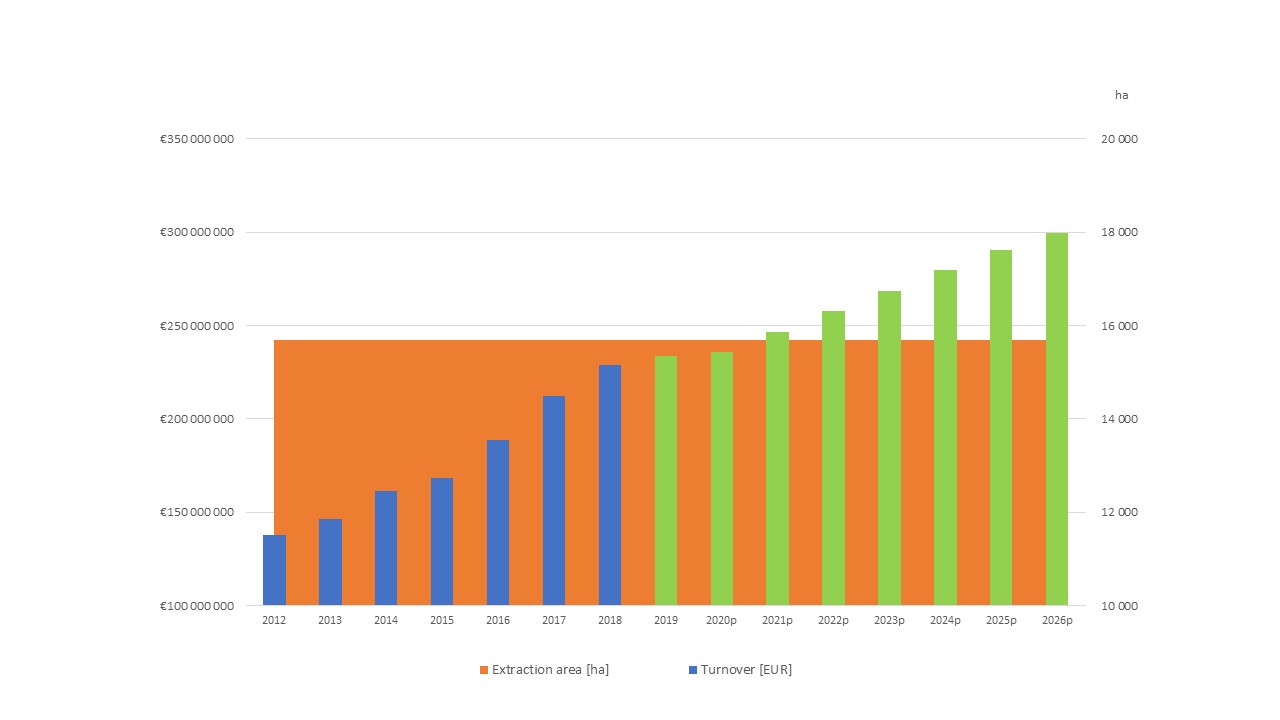
DIRECTIONS FOR USE OF THE FUND'S
FINANCING:
1. Improve GHG inventory methods
and use national GHG emission factors in Latvia's National GHG
Inventory Report which is prepared annually under the UN Framework
Convention on Climate Change. National GHG emission factors for
organic soils, calculated for Latvia by LIFE Restore project
(co-funded by the EC LIFE Environment and Climate Program) will
lead to a reduction of estimated GHG emissions by 1.8 million tons
of CO2 equivalent per year, or approximately by 17% of the total
national emissions. This will allow for a more accurate planning of
the national climate change mitigation policy and measures to be
implemented according to the real situation . Not only will it be
possible to recalculate emissions from the peat industry (reduction
of around 20%), but it will also be possible to refine emissions
calculated within the LULUCF sector. It is also important to
evaluate the possible improvements in GHG inventory methods,
specifically, in the inventory of horticultural peat emissions.
Emission calculations should take into account CO2 capture by
plants grown in peat, which is currently not taken into account.
This would enhance reduction of overall emissions in the LULUCF
sector. In addition, it would be important to find a solution to
include in the Latvian emission balance the capture that has took
place in all countries that use horticultural peat obtained in
Latvia.
2. To develop a set of compensatory measures for the state under
clear conditions, which means including compensatory measures in
the concept of climate neutrality. Compensation of emissions from
peat extraction and peat products production with emission capture
measures such as wetland restoration, afforestation of organic
soils, use of renewable energy sources in energy to achieve
"net-zero" GHG emissions in the industry as a whole.
3. After-use of historical post-harvested peatlands – to allocate
25% of the planned funding. Post-harvested peatlands where peat
extraction was discontinued at a time of re-establishment of
Latvia's independence (36% of the post-harvested peatlands in
Latvia ) and where peat extraction is not possible, shall be
re-used or converted to other types of land use. The most
appropriate after-use measures should be chosen which are
site-specific and most effective for GHG reduction. Such measures
are, for example, afforestation, wetland restoration, or their
return to economic cycle (berry plantations etc.). Where
appropriate, the development of infrastructure for nature tourism
and nature education should be considered.
4. Modernization of peat extraction technologies and technological
processes - 10% of the funding. The objective is to reduce GHG
emissions from the extraction process. Investments in research and
in the creation of related start-ups are necessary.
5. Development and promotion of horticulture and plant production
in Latvia – 30% of the funding. Development of seedling production
in Latvia, creation of export product (such as tree seedlings).
This would allow to avoid the transport emissions caused by the
export of peat as a raw material and the import of vegetables, as
well as increase the capture of GHGs right here in Latvia. It would
also reduce packaging usage and waste volume, and create new jobs
in the regions.
6. Production of peat products with added value – 35% of
funding.
• Construction of processing plants in Latvia; research. This would
increase the contribution of peat industry to the Latvian economy
as a whole, reduce the export of raw peat and create new jobs in
the regions.
• Improvement of peat substrates (seedlings for horticulture,
forestry) – investments in research, innovation and production
technologies are necessary.
• Development of innovative, promising products, creation of new
products in Latvia, including promotion and marketing of these
products, such as peat filters, sorbents (for water purification,
decontamination), construction materials (thermal insulation
materials, peat color, filling compounds), works of decorative
design and art , raw materials for the chemical industry,
industries of pulp and paper, and textiles.
FACTS
1. Economic aspects:
• Peat industry pays an average of 18.5 million EUR a year in taxes
. This means that in about three years the industry will pay in tax
the amount that the EC is offering to Latvia under the Just
Transition Fund over a seven-year period.
• Related industries (services to industry), such as pallet and
film manufacturers and transporters pay in taxes an average of 50
million EUR per year .
• Over the year, the industry pays an average of 54 million EUR in
taxes and salaries .
• Total exports of peat industry in 2018 reached 180 million EUR
.
• A contribution from the peat industry to the Latvian economy per
one hectare is 14,566 EUR (for comparison, EUR 400 per hectare in
dairy farming ).
• The peat industry employs 1,800 – 3,000 people, mainly in the
regions (depending on the season). The salaries of people working
in peat extraction and processing companies are higher than the
average salary in the region of operation and the average salary in
the country .
2. Peat is the basis of horticulture and forestry:
• 6,000 tree seedlings can be grown in one cubic meter of peat.
With these seedlings, 3 hectares of forest can be established,
which can capture 1,110 tons of CO2 in 50 years.
• Wood is an important product for the Latvian economy, which is
not only a significant export product (about 3.5 billion EUR), but
also a raw material for the production of other products.
• In one cubic meter of peat, also 7000 vegetable seedlings can be
grown, which can later produce 16 tons of cucumber crop or 32 tons
of tomato crop – a considerable amount of food.
3. The afforestation of organic agricultural soils (158 000 ha)
would result in a significant GHG emission reduction corresponding
to 4.3 million tons of CO2 eq year .
4. Latvia is a country rich in peat resources – 1.5 billion tons of
peat are accumulated in peat deposits. In total, peatlands cover
10% of the country's territory . Peat extraction is ongoing or has
occurred only in 4% of all peatlands (degraded areas) or 0.4% of
the territory of Latvia. Due to favorable climatic conditions, the
annual increase of peat in Latvia considerably exceeds the
extraction volumes. Approximately 1.6 million tons of peat are
accumulated per year (average accumulation rate is about 2 mm per
year ), or 0.4 million tons of carbon. Over a ten-year period, an
average of 0.95 million tons of peat is extracted annually,
resulting in an annual increase of 0.65 million tons. Peat is not a
fossil resource but a slow-renewable resource.
5. Latvia is a “superstate” of horticultural peat on a European
scale, as peat produced in Latvia corresponds to 31% of the peat
used in professional horticulture in Europe . Peat is an essential
part of the food production worldwide. Of the substrates used in
professional horticulture worldwide, 70% are peat substrates. It is
estimated that the world population will reach 10 billion by 2050,
and this will require 415% more substrates for food, ornamental
plants and tree seedlings. Demand for horticultural peat will
increase by at least 250% (taking into account the increase of
other substrates by up to 1000%) . Although Latvian peat is used
throughout Europe, the currently used GHG emission accounting
method states that all emissions stay in Latvia. This shortcoming
of method should be optimized as mentioned above. Or, by using peat
resources purposefully, the development of horticulture in Latvia
can be purposefully promoted.
6. When discussing the replacement of horticultural peat substrates
with other types of substrates (such as rock wool, expanded clay,
coco coir, others), GHG emissions from the production and use of
various peat substitutes, as well as their potential for further
use or recycling are not taken into account. For example, rock wool
is waste after its use, whereas peat after its use in seedling
cultivation is used for soil improvement, so promoting GHG emission
capture and producing no waste.
